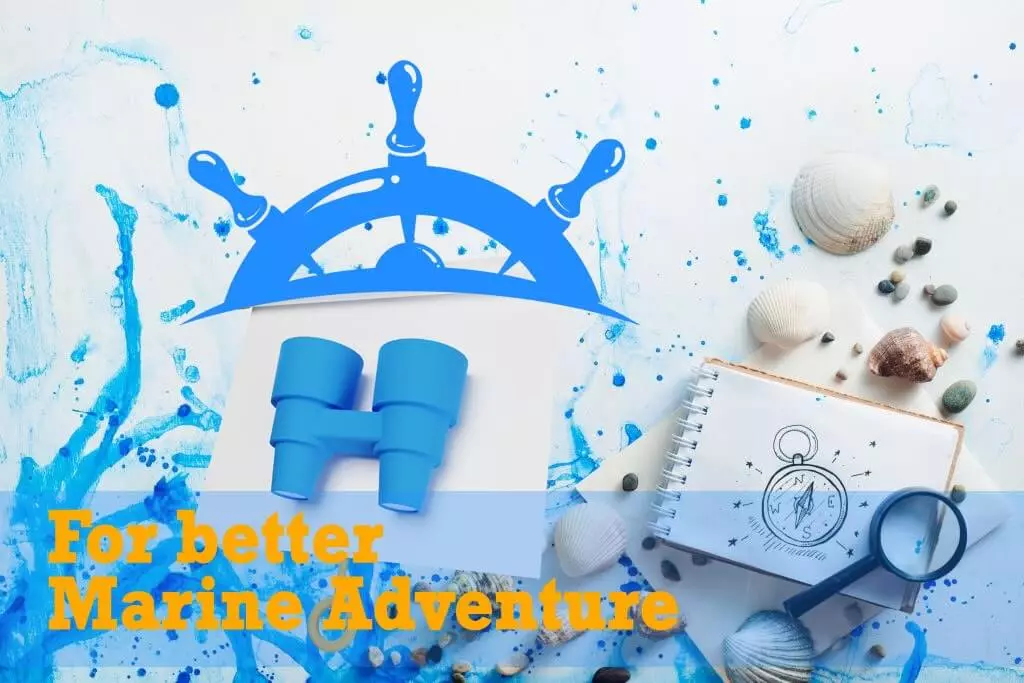Are you ready for your next adventure but you need the best marine binoculars with you? Don’t worry as many people have this issue. Finding the right marine binoculars can be a bit complicated.
These binos are slightly more advanced and tougher than the regular models. Since fans of the outdoors and professionals are among the main users, there are certain premium features to have in mind.
Not to mention that a tough design and efficiency are very desirable, too. We are here to simplify things for you.
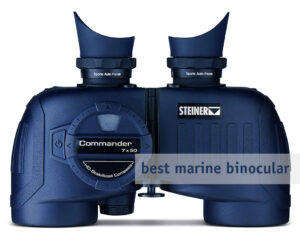
In this article we gathered some details you should know about marine binoculars together with the best models this year. So, let’s start!
The 10 Best Marine Binoculars
In the following parts, we present to you some of the best marine binoculars you can currently get on the market!
Gear Odds Recommendation
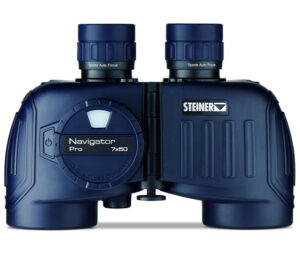
1. Steiner Navigator Pro 7×50 Marine Binoculars
As the optics have multiple coatings, users can expect very bright visuals with excellent color representation. The fact that light transmission is more than ninety-three percent helps a lot in this direction.
The model can be operated with even in low-light conditions. And with the sports automatic focusing, users don’t have to worry about having to focus on the model constantly. Of course, it has all the necessary proofing against fog as well as water. It’s shockproof to some extent, too.
There’s a minority of buyers who were dissatisfied because of the whole image stabilizer situation. Also, having a floating strap would be an asset. Anyway, check out these features and specifications:
- Magnification: 7x
- Lens diameter: 50mm
- Prism type: Porro prism
- Field of view: 370 feet at 1000 yards
- Material: Silicone, Rubber, Polycarbonate
- Waterproof & Shockproof maximum to 8 feet
2. Steiner 7×50 Binoculars
This model is known to be efficient and tough. Firstly, there is the military design with the exterior that’s easy to grip. It’s followed by the bright optical lenses that provide sharp views. Even if you are at a great distance the autofocus system enables you to see the objects clearly. Because of this, these binos can be used in all conditions.
Speaking of this, they are shockproof and waterproof. So, you don’t have to worry about the weather. And their armor is made of rubber, making them more secure.
As for some downsides, people report that there isn’t a built-in compass or a rangefinder. Here are some more specifications and details:
- Weight: 37 ounces
- Magnification: 7x
- Diameter of the objective lenses: 50 millimeters
- Dimensions: 8.2 x 2.8 x 5.2 inches
- Field of view: 354 feet at 1000 yards
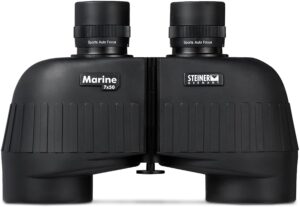
3. Steiner Marine Commander Series 7×50 Binoculars
The rugged and rubberized armoring makes this model exceptionally durable. Resistance to shock as well as extreme conditions is achieved. Additionally, the design is ergonomic and provides a strong grip. As proof of the water resistance, the binoculars can be submerged to maximum thirty-three feet.
The images are crisp and seem 3D. The field of view is pretty lengthy, too. To get bright images and easier navigation, the manufacturer included an efficient compass.
It should be noted that there is no image stabilizer. A few customers complained that it’s pretty heavy, too. However, the quality of the pictures makes up for that.
Let’s take a look at a couple of features and specifications:
- Weight: 40.2 ounces
- Height: 6.2 inches
- High-definition stabilized compass
- Magnification: 7x
- Width: 8.1 inches
- Lens diameter: 50 millimeters
- Warranty: lifetime
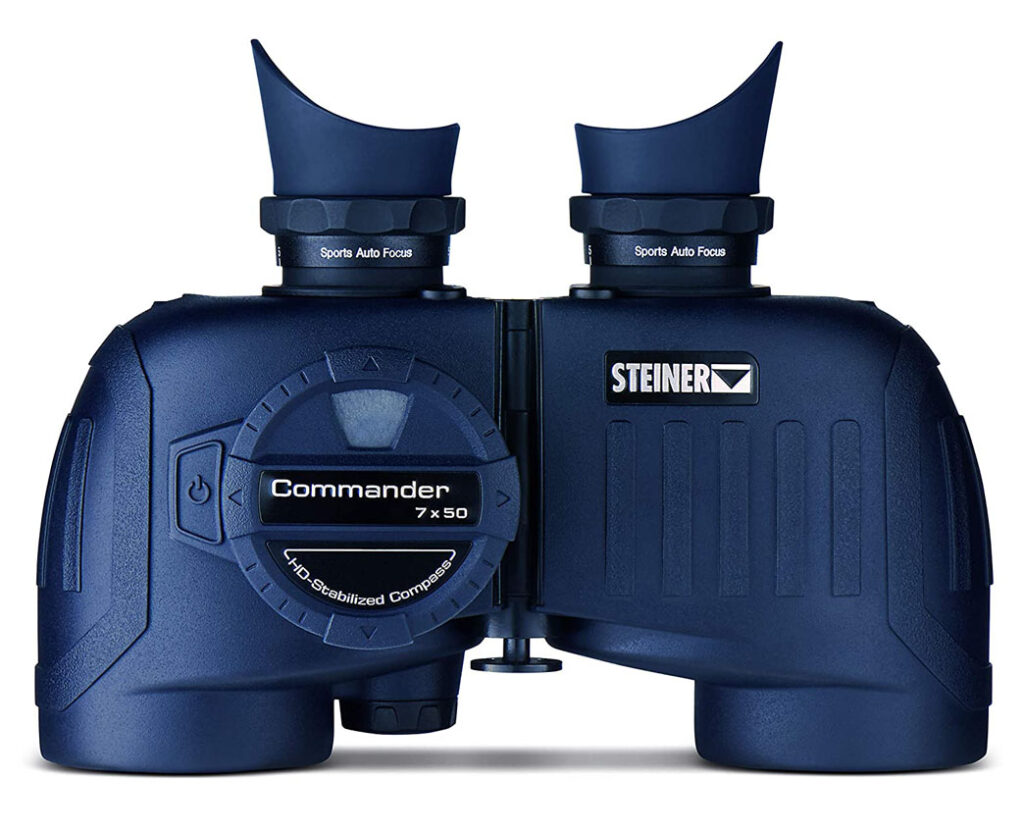
4. Bushnell H2O Roof Prism Binoculars
With a completely waterproof viewing experience as well as fog proof, it’s one of the more popular models. The structure is designed to be resistant to shocks, slips. The armoring provides a strong grip.
Thanks to the BaK-4 prism and the multiple coatings, the images are detailed and focused. Multiple other modifications can be made with the central focus system.
Something that has been pointed out as a con by some users is the slight heaviness. Also, it can’t be mounted on a tripod. What follows are some of the highlight specifications to consider:
- Dimensions: 7.00 x 6.00 x 3.00 inches
- Magnification: 10x
- Weight: 1.56 lbs
- Porro prism
- Lens diameter: 42 millimeters

5. Fujinon Mariner 7×50 WPC-XL Porro Prism Binoculars
Much like other quality models, the prism is of the porro type. That means that the visuals can boast with exceptional focus as well as clarity. The model has an individual focus system.
The design is very elegant and sleek. Know that the manufacturer thought of protection, too. That’s why the company put a neck strap that helps the binos float. Having said that, you can access the reticle display and the compass by looking through the left eyepiece. It has a built-in LED night light.
Some reviewers consider the model to belong in the category of budget binoculars. Moreover, they see the fact that it doesn’t come with a case as a small drawback.
These are the most notable specifications as well as aspects of the model:
- Eye relief: 18 millimeters
- Lens diameter: 50 millimeters
- Dimensions: 3.1 x 13.03 x 9.45 inches
- Magnification: 7x
- Warranty: limited, 5 years
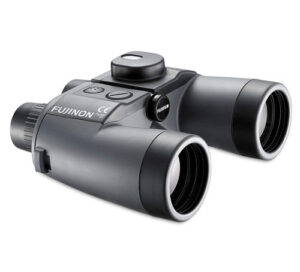
6. ESSLNB 7X50 Binoculars
The model’s rangefinder, compass, and calculator help the user navigate and measure the distance between objects. It’s nitrogen-filled and made to be protected against water, moisture, fog, and similar.
With the magnification capabilities, you can see much and yet keep the image stability. The prism is BaK-4 and the model has multiple coatings. All of enables more light to be transmitted and to eliminate distortion and mistakes with colors. Thanks to the individual focusing abilities, users can modify the left and the right diopter.
Something a few customers didn’t like was that that the model isn’t designed for night vision. Only the compass glows in the dark.
Are you interested in the specifications? Here they are:
- Eyepiece diameter: 23 millimeters
- Magnification: 7x
- Diameter of exit pupils: 6.8 millimeters
- Field of view: 396 feet at 1000 yards
- Fold-up eyecups
- Interpapillary distance: from 56 to 72 millimeters
- Lens diameter: 50 millimeters
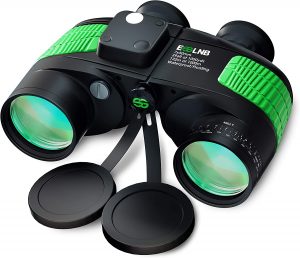
7. Canon 10×42 L Image Stabilization Binoculars
When it comes to image stabilization, a few models can compare to Canon’s binoculars. Actually, this is the first-ever waterproof model the company produced. And it comes with a strong magnification of 10 times. This enhances the view.
For utilization in low light, they have a 4.2 millimeters exit pupil. Because of this, the images are very clear and sharp. Glass wearers will find pleasure in knowing that they have an option for modifying the dioptric.
As for downsides, some people have troubles with the slower focus and the bulkiness. Also, the price is a bit high.
In the following lines, we present some other specifications that may interest you:
- Magnification: 10x
- Diameter of the objective lenses: 42 millimeters
- Multi-coated optics
- Porro prism
- Center focus
- Waterproof and fogproof
- Weight: 2.45 pounds
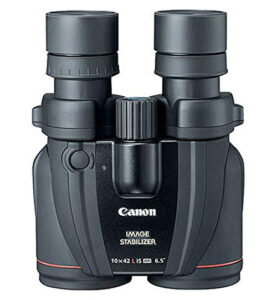
8. Hooway 7×50 Military Binoculars
The thing that stands out about these binos is the adaptability to extreme conditions. They are totally waterproof. Therefore, they can even float above water without any issues. The nitrogen keeps the fog at bay, too. At the same time, they are stable and comfortable to hold. The rubber armor contributes to this.
It’s worth mentioning that they are very durable. The Porro prism provides a large field of view. Together with the multi-coated optics, they ensure the views you get are bright and clear. For better orientation, this model also features an internal rangefinder and a compass.
When asked about possible cons, users say that the caps of the lenses tend to fall off easily. Here are some more specifications:
- Weight: 2.2 pounds
- Tripod adaptable
- Angle of vision: 7.5 degree
- Magnification: 7x
- Field of view: 396 feet at 1000 yards
- Individual eye focus
- Diameter of the objective lenses: 50 millimeters
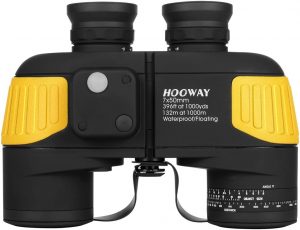
9. Aomekie Marine Military Binoculars
From birdwatching and hunting to boating, this model can be utilized for many outside activities. It can boast with its affordable price and premium features.
The magnification of 10 times offers wide views and bright images. Those that wear glasses should know that the eyecups are foldable. Also, the BaK-4 prism increases the color reproduction. As for dropping them in the water, you shouldn’t worry as they are waterproof. The design incorporates anti-shake and fogproof features, as well.
Some users complain that there are issues with the eye adjustment. But it’s nothing too serious. Other details and specifications to have in mind are:
- Weight: 2.2 pounds
- Field of view: 132 meters at 1000 meters
- Rubber armor
- Multi-coated BaK-4 Porro prism
- Angle of vision: 7.5 degree
- Diameter of the objective lenses: 50 millimeters
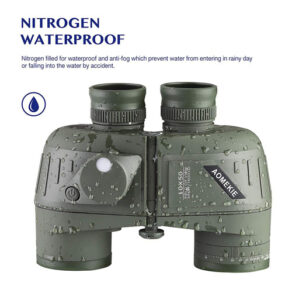
10. Tengchang 10×50 Binoculars w/Rangefinder & Compass
These dark black binoculars both look good and serve the users well. As the name suggests, they have a compass and rangefinder inside. That way you can discover locations and sizes of objects.
As they are filled with nitrogen, they can be utilized in harsh conditions. This is convenient for marines and lovers of the outdoors. Also, you get the brightest views due to the large lenses that are multi-coated and the BaK-4 prism. The only thing users reported as an issue was the night vision. So, check it out before you make the purchase.
More detailed specifications are as follow:
- Field of view: 132 meters at 1000 meters
- Waterproof and fogproof
- Magnification: 10x
- Exit pupil: 8 millimeters
- BaK-4 Porro prism

Read More: The 7 Marine Binoculars under $500
Buyer’s Guide
We dedicate this section to the complete guide for buyers. We’ll cover some of the most important aspects of binoculars to consider before purchasing. Some helpful tips are included! There are several features you should consider when purchasing binoculars. These features include magnification, focal length, objective lens diameter, eye relief, field of view, and size.
Magnifications
The basic function of binoculars is to magnify objects in the distance. In other words, to bring them closer to you than they are.
If you want to easily learn the magnification power of a model, know that it’s right there in the name. With that being said, each model has two numbers with an ‘x’ between them. The first number is for magnification.
For the right binoculars, magnification of 7x or 8x is highly recommended. That’s because it will enable you to see distanced objects larger and the image won’t be distorted. Anything north of that will provide a shaky image. When you consider the fact that you’ll probably on a boat that shakes nonetheless, you’re apt to see almost nothing. Also, the field of view will be significantly reduced.
Focal Length
The focal length of binoculars is measured in millimeters. A longer focal length means that the binoculars can magnify distant objects better than shorter focal length models. However, you should also consider the size and weight of binoculars when selecting a pair. Lower-powered binoculars are lighter and easier to carry than high-power models. Many people prefer to use high-powered compact binoculars for fitness purposes because they are lighter weight than longer ones. A long focal length is also an advantage for bird watchers who like to observe birds from far away without disturbing them, or for people who like to observe the ocean waves at various distances without moving their position too much.
Objective Lens Diameter
The objective lens diameter of binoculars is measured in millimeters. Its size is related to the magnification, which means that the higher the magnification, the larger the objective lens diameter. The larger diameter means that more light enters the lens, meaning that you can look at distant objects in dim light. However, you should also consider whether or not you are willing to carry large, high-powered binoculars when selecting a pair. Many compact powerful models are available that can magnify distant objects while still being easy to carry around.
Eye Relief
A comfortable eye relief distance is very important for people who wear eyeglasses because their eyes may become strained otherwise. That is why eye relief is measured in millimeters, which indicates the distance from the object lens to where your eyes are when you look through the binoculars. The greater the distance, the more comfortable your eyes will be while using these binoculars.
Field of View
The field of view is the area that you can see when looking through binoculars. The area of view depends on how wide a lens has been used for magnification. The wider the lens diameter, the larger field of view you will have. Many compact models vary in magnification and objective lens diameter to provide a large field of view at a lower price than many high-powered models.
Prism
There aren’t many options to choose from. That’s because you can decide from just two:
Roof prism – This is a very popular type for a variety of outdoor activities. Probably a reason for that is that the models that have this prism are more compact, lighter, and more ergonomic. Thanks to modern technology, the roof prisms transmit light as good as the porro ones.
Porro prism – Traditionally, marine binos were made using this type of prism. As we mentioned, this prism enables a better transmission of light. Also, the size of the objective lenses is bigger. Porro prism can make the vision seem three-dimensional by giving much more depth.
Fog- and Waterproof
It’s imperative to look for binoculars that won’t be destroyed by water or fog. If fog appears, that may ruin the whole viewing experience and make the binoculars useless. Since you’ll spend most of your time on the sea, you’ll need these models to see the intended objects. Also, they work well in case of harsh weather conditions.
One thing to watch out for is ‘nitrogen-purged’ and such. That means that gas from inside will prevent moisture and corrosion from damaging the model. These items are known for lasting longer, too.
Unique Features
Since we’re talking about marine binoculars, these models have some special features. They didn’t say in vain that the devil is in the details. So, it’s a good idea to look for some models that have some of these extra features. They can sometimes come in very handy.
Some binoculars come with a compass. Most of them are built-in. What’s more, some models sport digital compasses and even illuminated ones. Binoculars for marine purposes are usually waterproof. And floating straps sound like a terrific accessory. Know that in some cases you can get some with the purchase. If not, you can buy them separately if you like.
FAQs (Frequently Asked Questions)
Q. Why should I buy marine binoculars instead of using regular binoculars?
Answer: One of the basic features, which separate marine binos from the rest, is waterproofing. Unlike other models, a waterproof one is suitable for adventures on the water. They will serve you in whatever weather condition you find yourself in. Fog protection is another strong asset of marine models. The lens stays crystal clear. If you get nitrogen-purged binoculars, then you’ll get all of that plus resistance to internal rust. Usually, binoculars for stadium events or birdwatching can’t float on water surfaces. Instead, marine ones have that ability. What’s more, some ordinary binos (like the ones for hunting, for example) can possess a laser rangefinder. This type of rangefinder will be unusable on the water, though. That’s why a reticule rangefinder is adequate for seeing the object’s distance. Another reason is that marine models most frequently have a compass, too. So, it’s safe to assume that marine binos are increasingly different. That’s because they’re made for special situations like yours. Thus, they have all the necessary features to be useful.
Q. Where should I keep my marine binoculars while I’m not using them?
Answer: It’s highly important for the storage place for your binos to be completely dry and safe from impacts or other damage. Usually, people use binocular cases which can be easily situated anywhere on a boat or ship. That way you’ll access them quickly and without any issues. A pro tip is to have the lens caps when you aren’t using the model. That way you protect it from scratches or dirt.
Q. What are some of the lens coatings found in the marine binoculars?
Answer: This is something marine models have in common with standard binoculars. Among the most quality lens coatings, one can find ED glass, BaK-4 prisms, fully multi-coated lenses, and such. ED glass is short for extra-low dispersion glass. It’s known to reduce the rainbow effect that can appear at the edge of the vision. Models with this type of coating usually have a slightly higher price. Many people state that the BaK-4 prism is much better than others like the BK-7. During internal reflections, plenty of light is saved due to this coating. Furthermore, with the fully multi-coated lenses, the users know that all of the internal air-to-glass surfaces are covered. That results in not losing a lot of light and better overall light transmission.
Q. What is the adequate eye relief in marine binoculars for people who wear glasses?
Answer: If you have to operate with binoculars with your spectacles on, it’s advised to consider an eye relief of minimum 15 millimeters. 17 millimeters would be an even more efficient solution. After all, it largely depends on the type of glasses as well as your face’s shape. Manufacturers usually make the modifiable eyecups that work by pushing and pulling. Also, some eye cups can be wither twisted up and down. However, each of these has its positive sides and drawbacks.
In the bottom line
If you have plans to go on a boat and want to take a pair of binoculars, you should be aware that the regular one that lies at your home simply won’t do. That’s because it will be easily damaged by the water. And it can even get lost in the vast water surface without you finding it. Being on the water warrants a special type of binoculars. And that is marine models.
So, it’s recommended to look for fog and waterproofing, the capability to float, as well as having extra features like a rangefinder, compass, and such. Also, be guided by your needs as well as your budget. And we’re sure that you’ll come across the pair that’s presently most suitable for you. We hope that we provided you with enough resources and options to consider before you make the final purchase. There’s nothing left for us to do except to wish you good luck and happy shopping!

